|
|
|

|
|
2014 (vol. 14)
|
|
In memoriam of my colleague and friend Guy Tronchetti (1938-2014)
Michel MOULLADE
| HTML  | PDF
| PDF  [112 KB]
| DOI:
10.4267/2042/56047
[112 KB]
| DOI:
10.4267/2042/56047
|
|
 The chief editor of a prestigious scientific journal, who is about to publish a major article of which Guy is one of the lead authors, replied to the news of his passing:
"I am very sorry to hear about that. I have known Guy Tronchetti from publications, for a long time. It is really
sad." This quote and Googling his name show that, according to his publications, some of them very recent, Guy was still both at the cutting edges of research and a scientist at an international level. His great modesty did not allow people to necessarily acknowledge this, especially those who did not attempt to overcome such an obstacle. (...) The chief editor of a prestigious scientific journal, who is about to publish a major article of which Guy is one of the lead authors, replied to the news of his passing:
"I am very sorry to hear about that. I have known Guy Tronchetti from publications, for a long time. It is really
sad." This quote and Googling his name show that, according to his publications, some of them very recent, Guy was still both at the cutting edges of research and a scientist at an international level. His great modesty did not allow people to necessarily acknowledge this, especially those who did not attempt to overcome such an obstacle. (...)
|
|
Carnets Geol., vol. 14, Obituary notice, p. 483-487
Manuscript online since December 24, 2014
|
|
Significance of partial leaching in calcareous ooids: The case study of Hauterivian oolites in Switzerland
Bruno GRANIER, Vincent BARBIN & Jean CHAROLLAIS
| HTML  | PDF
| PDF  [1,312 KB]
| DOI:
10.4267/2042/56045 [1,312 KB]
| DOI:
10.4267/2042/56045
|
|
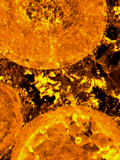 Abstract: In the Canton of Vaud (Switzerland), two Hauterivian oolitic units were penetrated by a borehole. In both units, the ooids are partly leached. More specifically, the ooid cortices were partly leached and some ooid nuclei appear suspended in the middle of cortical moldic cavities created by leaching, rather than having fallen to the bottom of these cavities before the final cementation take place. We demonstrate that these ooids were originally calcitic, not aragonitic, not "two-phase" nor "bimineral". This leaching is not an early diagenetic feature related to subaerial exposure, but a late diagenetic feature, possibly related to the migration of acidic pore waters, brought about by Alpine tectonics and/or karstification. Abstract: In the Canton of Vaud (Switzerland), two Hauterivian oolitic units were penetrated by a borehole. In both units, the ooids are partly leached. More specifically, the ooid cortices were partly leached and some ooid nuclei appear suspended in the middle of cortical moldic cavities created by leaching, rather than having fallen to the bottom of these cavities before the final cementation take place. We demonstrate that these ooids were originally calcitic, not aragonitic, not "two-phase" nor "bimineral". This leaching is not an early diagenetic feature related to subaerial exposure, but a late diagenetic feature, possibly related to the migration of acidic pore waters, brought about by Alpine tectonics and/or karstification.
|
|
Carnets Geol., vol. 14, no. 22, p. 471-481
Published online in final form (pdf) on December 24, 2014
|
|
Borings and etchings in the Upper Bathonian-Lower Callovian oolite of the Paris Basin (France)
Bruno GRANIER
| HTML  | PDF
| PDF  [1,250 KB]
| DOI:
10.4267/2042/56043 [1,250 KB]
| DOI:
10.4267/2042/56043
|
|
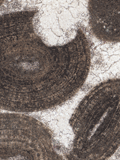 Abstract: The
oolite of the "Dalle Nacrée" Formation in the Paris Basin is made of marine
calcareous ooids with, from base to top, radial (and therefore likely to have
been calcite), concentric and micritic fabrics, each corresponding to a discrete
stratigraphic unit. Several hardgrounds and oolitic pebble-cobble layers in the succession are encrusted and bored. Three
main types of boring have been identified ranging in sizes from some tens
of µm (sponge borings) to centimeters (bivalve borings), with an intermediate
category (worm borings). Some worm borings have rough walls, where early marine
fibrous cement is less corroded than the cortices of cemented ooids. The key to
understanding this differential dissolution could be related to organic matter,
present within the ooid cortices but lacking in the fibrous cement. Polychaete
worms that use chemical means (enzymes or acids) to bore are probably
responsible for these peculiar borings. A secondary conclusion is that partly or fully leached ooid cortices do not necessarily
indicate an original aragonitic mineralogy of the dissolved parts. Abstract: The
oolite of the "Dalle Nacrée" Formation in the Paris Basin is made of marine
calcareous ooids with, from base to top, radial (and therefore likely to have
been calcite), concentric and micritic fabrics, each corresponding to a discrete
stratigraphic unit. Several hardgrounds and oolitic pebble-cobble layers in the succession are encrusted and bored. Three
main types of boring have been identified ranging in sizes from some tens
of µm (sponge borings) to centimeters (bivalve borings), with an intermediate
category (worm borings). Some worm borings have rough walls, where early marine
fibrous cement is less corroded than the cortices of cemented ooids. The key to
understanding this differential dissolution could be related to organic matter,
present within the ooid cortices but lacking in the fibrous cement. Polychaete
worms that use chemical means (enzymes or acids) to bore are probably
responsible for these peculiar borings. A secondary conclusion is that partly or fully leached ooid cortices do not necessarily
indicate an original aragonitic mineralogy of the dissolved parts.
|
|
Carnets Geol., vol. 14, no. 21, p. 461-469
Published online in final form (pdf) on December 24, 2014
|
|
Devonian Phillipsastreid tetracorals of the genus Rozkowskaella from the Holy Cross Mountains, Poland
Tomasz WRZOŁEK
| HTML  | PDF
| PDF  [9,340 KB]
| DOI:
10.4267/2042/56041 [9,340 KB]
| DOI:
10.4267/2042/56041
|
|
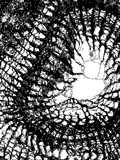 Abstract: Solitary or weakly colonial Phillipsastreid tetracorals of the Upper Frasnian of Holy Cross
Mountains, Poland, with triangular to oval shape of transverse-section and tendency towards reduction of the horseshoe
dissepiments, are included here in the genus Rozkowskaella, with Rozkowskaella sandaliformis, R. cf. sandaliformis and Rozkowskaella sp. Abstract: Solitary or weakly colonial Phillipsastreid tetracorals of the Upper Frasnian of Holy Cross
Mountains, Poland, with triangular to oval shape of transverse-section and tendency towards reduction of the horseshoe
dissepiments, are included here in the genus Rozkowskaella, with Rozkowskaella sandaliformis, R. cf. sandaliformis and Rozkowskaella sp.
|
|
Carnets Geol., vol. 14, no. 20, p. 439-459
Published online in final form (pdf) on December 24, 2014
|
|
Two new species of Early Pleistocene marine ostracods from Southeast Sicily
Francesco SCIUTO
| HTML  | PDF
| PDF  [1,769 KB]
| DOI:
10.4267/2042/56039 [1,769 KB]
| DOI:
10.4267/2042/56039
|
|
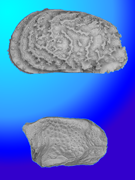 Abstract: Two fossil species of Ostracoda belonging to the genera Urocythereis Ruggieri,
1950, and Semicytherura Wagner,
1957, discovered in the Lower Pleistocene shallow marine sandy-silty sediments outcropping at
"Cartiera Molino" (F. 276, IV NO, Vittoria, Southeast Sicily) are described and figured. Abstract: Two fossil species of Ostracoda belonging to the genera Urocythereis Ruggieri,
1950, and Semicytherura Wagner,
1957, discovered in the Lower Pleistocene shallow marine sandy-silty sediments outcropping at
"Cartiera Molino" (F. 276, IV NO, Vittoria, Southeast Sicily) are described and figured.
|
|
Carnets Geol., vol. 14, no. 19, p. 429-437
Published online in final form (pdf) on December 24, 2014
|
|
Revision of "Falaise de Blanche" (Lower Cretaceous) in Lebanon, with the definition of a Jezzinian Regional Stage
Sibelle MAKSOUD, Bruno GRANIER, Dany AZAR, Raymond GÈZE, Jean-Claude PAICHELER & Josep A. MORENO-BEDMAR
| HTML  | PDF
| PDF  [4,404 KB]
| DOI:
10.4267/2042/54359 [4,404 KB]
| DOI:
10.4267/2042/54359
|
|
 Abstract: The "Falaise de Blanche"
is a prominent cliff, consisting mostly of Lower Cretaceous limestones that extends as linear outcrops over most of the Lebanese territory and provides geologists a remarkable reference for stratigraphic studies. However, until now, this unit was lacking a clear definition. We introduce herein the Jezzinian Regional Stage, the type-locality of which is
at Jezzine. It equates as an unconformity-bounded unit and, per definition, it is framed by two discontinuities. Because we identified an additional, median sequence-boundary, poorly-expressed in the type-section but better at
Aazour, only 4.5 km westward of Jezzine, the new regional stage implicitly spans two sequences. The lithostratigraphic framework being properly redefined, we were able to investigate time-constrained micropaleontological assemblages, consisting mostly of benthic foraminifers and calcareous algae. Typically Southern
Tethysian, these assemblages contribute to high-resolution, holostratigraphic correlations with the Persian Gulf area, on the
eastern part of the Arabian Plate. The Jezzinian interval correlates with the upper part of the Kharaibian Regional Stage (also known as "Thamama II" reservoir unit in the oil industry). In turn, the Jezzinian is indirectly correlated with the Northern Tethysian Urgonian stratigraphic units where it corresponds to a rather short interval encompassing the standard Barremian - Bedoulian stage boundary. Locally the upper discontinuity is associated to a significant intra-Bedoulian hiatus. The macrofossil assemblages found in the Jezzinian (echinids) and above it (ammonites) support, or at least do not contradict, our micropaleontological dating. Abstract: The "Falaise de Blanche"
is a prominent cliff, consisting mostly of Lower Cretaceous limestones that extends as linear outcrops over most of the Lebanese territory and provides geologists a remarkable reference for stratigraphic studies. However, until now, this unit was lacking a clear definition. We introduce herein the Jezzinian Regional Stage, the type-locality of which is
at Jezzine. It equates as an unconformity-bounded unit and, per definition, it is framed by two discontinuities. Because we identified an additional, median sequence-boundary, poorly-expressed in the type-section but better at
Aazour, only 4.5 km westward of Jezzine, the new regional stage implicitly spans two sequences. The lithostratigraphic framework being properly redefined, we were able to investigate time-constrained micropaleontological assemblages, consisting mostly of benthic foraminifers and calcareous algae. Typically Southern
Tethysian, these assemblages contribute to high-resolution, holostratigraphic correlations with the Persian Gulf area, on the
eastern part of the Arabian Plate. The Jezzinian interval correlates with the upper part of the Kharaibian Regional Stage (also known as "Thamama II" reservoir unit in the oil industry). In turn, the Jezzinian is indirectly correlated with the Northern Tethysian Urgonian stratigraphic units where it corresponds to a rather short interval encompassing the standard Barremian - Bedoulian stage boundary. Locally the upper discontinuity is associated to a significant intra-Bedoulian hiatus. The macrofossil assemblages found in the Jezzinian (echinids) and above it (ammonites) support, or at least do not contradict, our micropaleontological dating.
|
|
Carnets Geol., vol. 14, no. 18, p. 401-427
Published online in final form (pdf) on November 14, 2014
|
|
The genera Subgrossouvria Spath and Orionoides Spath (Ammonitina, Perisphinctidae) from the Leckenbyi Horizon (Upper Callovian, Athleta Zone) of Montreuil-Bellay (Maine-et-Loire, France)
Alain BONNOT, Pierre-Yves BOURSICOT & Patrice FERCHAUD
| HTML  | PDF
| PDF  [11,574 KB]
| DOI:
10.4267/2042/54363 [11,574 KB]
| DOI:
10.4267/2042/54363
|
|
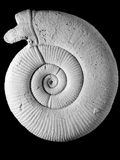 Abstract: In the Montreuil-Bellay area (Maine-et-Loire, France), the lowermost bed of the Upper Callovian (Leckenbyi Horizon) contains a very abundant ammonite fauna (N=3275).
The Family Perisphinctidae is represented by Choffatia isabellae Bonnot et al., the
genus Pseudopeltoceras Spath, the genus Subgrossouvria Spath,
which includes S. famula (Bean in Spath) and S. crassa Gérard & Contaut,
and the genus Orionoides Spath, which comprises O. indicus Spath. Thanks to the abundance and quality of the material, it was possible to describe and figure macroconchs and microconchs of these three species, including adult specimens with preserved peristome. The stratigraphical ranges of these
taxa are also specified and their potential descendants can be considered. These species are unknown in the uppermost Middle Callovian, and we assume that they
colonized the northwestern part of the European platform via the southern margin of the Tethys, as
did Peltoceras marysae Bonnot et al. and Choffatia isabellae Bonnot et al. Abstract: In the Montreuil-Bellay area (Maine-et-Loire, France), the lowermost bed of the Upper Callovian (Leckenbyi Horizon) contains a very abundant ammonite fauna (N=3275).
The Family Perisphinctidae is represented by Choffatia isabellae Bonnot et al., the
genus Pseudopeltoceras Spath, the genus Subgrossouvria Spath,
which includes S. famula (Bean in Spath) and S. crassa Gérard & Contaut,
and the genus Orionoides Spath, which comprises O. indicus Spath. Thanks to the abundance and quality of the material, it was possible to describe and figure macroconchs and microconchs of these three species, including adult specimens with preserved peristome. The stratigraphical ranges of these
taxa are also specified and their potential descendants can be considered. These species are unknown in the uppermost Middle Callovian, and we assume that they
colonized the northwestern part of the European platform via the southern margin of the Tethys, as
did Peltoceras marysae Bonnot et al. and Choffatia isabellae Bonnot et al.
|
|
Carnets Geol., vol. 14, no. 17, p. 351-399
Published online in final form (pdf) on November 14, 2014
|
|
Nannofossils and foraminifera from the Salamanca Formation (Paleocene) in Punta Peligro Norte (Chubut, Argentina)
Margarita SIMEONI
| HTML  | PDF
| PDF  [1,700 KB]
| DOI:
10.4267/2042/54361 [1,700 KB]
| DOI:
10.4267/2042/54361
|
|
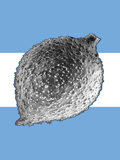 Abstract: An assemblage of nannofossils from the Salamanca Formation is reported for the first time from the Punta Peligro Norte locality in the San Jorge Gulf Basin, Argentina. Several recognized nannofossils have a stratigraphic distribution within the lower Danian. The assemblage of nannofossils and associated foraminifera is here discussed taking into account biostratigraphic and paleoecological
aspects. Abstract: An assemblage of nannofossils from the Salamanca Formation is reported for the first time from the Punta Peligro Norte locality in the San Jorge Gulf Basin, Argentina. Several recognized nannofossils have a stratigraphic distribution within the lower Danian. The assemblage of nannofossils and associated foraminifera is here discussed taking into account biostratigraphic and paleoecological
aspects.
|
|
Carnets Geol., vol. 14, no. 16, p. 343-349
Published online in final form (pdf) on November 14, 2014
|
|
Ostracodes from the Upper Cretaceous deposits of the Potiguar Basin, northeastern Brazil: taxonomy, paleoecology and paleobiogeography. Part 2: Santonian-Campanian
Enelise K. PIOVESAN, Maria Cristina CABRAL, Jean-Paul COLIN, Gerson FAUTH & Cristianini TRESCASTRO BERGUE
| HTML  | PDF
| PDF  [8,480 KB]
| DOI:
10.4267/2042/54151
[8,480 KB]
| DOI:
10.4267/2042/54151
|
|
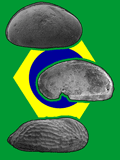 Abstract: Sixty-four Ostracoda taxa were recorded from the Santonian–Campanian of Potiguar Basin, northeastern Brazil. The following new species were described: Triebelina anterotuberculata, Triebelina obliquocostata, Cophinia ovalis, Fossocytheridea potiguarensis, Ovocytheridea anterocompressa, Ovocytheridea triangularis, Perissocytheridea jandairensis, Semicytherura musacchioi and Protocosta babinoti. The faunal association indicates predominantly shallow marine environments, intercalated with typically mixohaline levels. These species are mostly endemic, although the presence of six species common to West and North Africa shows that migration was still possible by the end of the Cretaceous. Abstract: Sixty-four Ostracoda taxa were recorded from the Santonian–Campanian of Potiguar Basin, northeastern Brazil. The following new species were described: Triebelina anterotuberculata, Triebelina obliquocostata, Cophinia ovalis, Fossocytheridea potiguarensis, Ovocytheridea anterocompressa, Ovocytheridea triangularis, Perissocytheridea jandairensis, Semicytherura musacchioi and Protocosta babinoti. The faunal association indicates predominantly shallow marine environments, intercalated with typically mixohaline levels. These species are mostly endemic, although the presence of six species common to West and North Africa shows that migration was still possible by the end of the Cretaceous.
|
|
Carnets Geol., vol. 14, no. 15, p. 315-341
Published online in final form (pdf) on October 14, 2014
|
|
Temporal and latitudinal trends in the biodiversity of European Atlantic Cenozoic gastropod (Mollusca) faunas. A base for the history of biogeographic provinces
Pierre LOZOUET
| HTML  | PDF
| PDF  [2,328 KB]
| DOI:
10.4267/2042/54150
[2,328 KB]
| DOI:
10.4267/2042/54150
|
|
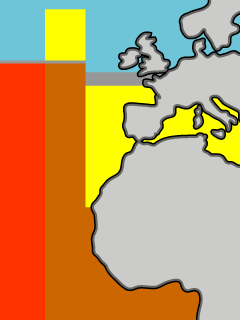 Abstract: A general overview of the biodiversity of the marine fauna during the Tertiary period is developed in the context of the biogeographical evolution of the European realm. This study combines a reappraisal of the literature with a unique first-hand source of data on the richest marine group (the gastropods) from over a 25 million year period (Early Oligocene to Late Miocene). In total the French deposits have yielded more than 10,000 species from the Eocene to the
Upper Miocene. Evidence of significant bias in the fossil record is pointed out for the Palaeocene (Danian) and Upper Eocene
(Priabonian). For the period considered (Palaeocene to Late Miocene, ca 50 million years) the second highest diversity is reported in the Late Oligocene. This study reveals also the importance of pre-Miocene extinctions of genera. The Oligocene was when the latitudinal differentiation of the faunas was greatest. The local generic gastropod richness ranges from 59 (Rupelian of Belgium) to 494 (Chattian of
Aquitaine). A clear trend towards homogenization appears in the Late Oligocene which leads
to the development of a vast biogeographical region named Euro-West Africa. This faunal evolutionary pattern has never been demonstrated before and is a novel feature of the biogeography of the Eastern-Atlantic region. Abstract: A general overview of the biodiversity of the marine fauna during the Tertiary period is developed in the context of the biogeographical evolution of the European realm. This study combines a reappraisal of the literature with a unique first-hand source of data on the richest marine group (the gastropods) from over a 25 million year period (Early Oligocene to Late Miocene). In total the French deposits have yielded more than 10,000 species from the Eocene to the
Upper Miocene. Evidence of significant bias in the fossil record is pointed out for the Palaeocene (Danian) and Upper Eocene
(Priabonian). For the period considered (Palaeocene to Late Miocene, ca 50 million years) the second highest diversity is reported in the Late Oligocene. This study reveals also the importance of pre-Miocene extinctions of genera. The Oligocene was when the latitudinal differentiation of the faunas was greatest. The local generic gastropod richness ranges from 59 (Rupelian of Belgium) to 494 (Chattian of
Aquitaine). A clear trend towards homogenization appears in the Late Oligocene which leads
to the development of a vast biogeographical region named Euro-West Africa. This faunal evolutionary pattern has never been demonstrated before and is a novel feature of the biogeography of the Eastern-Atlantic region.
|
|
Carnets Geol., vol. 14, no. 14, p. 273-314
Published online in final form (pdf) on October 14, 2014
|
|
Origin of the Tethyan Hemihoplitidae tested with cladistics (Ancyloceratina, Ammonoidea, Early Cretaceous): an immigration event?
Didier BERT & Stéphane BERSAC
| HTML  | PDF
| PDF  [612 KB]
| DOI:
10.4267/2042/54149
[612 KB]
| DOI:
10.4267/2042/54149
|
|
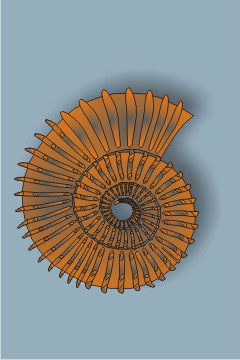 Abstract: The Late Barremian Hemihoplitidae (Ancyloceratina, Ammonoidea) are
widely known in the northern Tethyan Margin and the Essaouira-Agadir Basin (Morocco). Their rapid evolution and diversification make them one of the key groups for that period, but their origin remains
poorly known and several competing hypotheses have been published. These hypotheses are tested here with cladistic analysis in order to reject those receiving the least support and discuss
those well supported. The analysis discards the Crioceratitidae, Emericiceratidae (Emericiceras and Honnoratia) and Toxancyloceras as stem-groups of the Hemihoplitidae (Gassendiceras). The Toxancyloceras appear
instead to be a sister-taxon of the Moutoniceras, so we propose the latter to be classified
with the Ancyloceratidae rather than with the Heteroceratidae. The best supported hypothesis assumes that the Hemihoplitidae first appeared suddenly in the Essaouira-Agadir Basin at the end of the Early Barremian from small populations of
Boreal Paracrioceras. These latter could have migrated southward episodically before invading the northern Tethyan margin at the beginning of the Late Barremian. As a consequence, the Paracrioceratidae fam. nov. is proposed to
include the Boreal groups Fissicostaticeras / Paracrioceras / Parancyloceras, and Gassendiceras essaouirae sp. nov. is proposed as a new name for the Moroccan endemic "Barrancyloceras" maghrebiense sensu Company et al.,
2008, non Immel, 1978. Abstract: The Late Barremian Hemihoplitidae (Ancyloceratina, Ammonoidea) are
widely known in the northern Tethyan Margin and the Essaouira-Agadir Basin (Morocco). Their rapid evolution and diversification make them one of the key groups for that period, but their origin remains
poorly known and several competing hypotheses have been published. These hypotheses are tested here with cladistic analysis in order to reject those receiving the least support and discuss
those well supported. The analysis discards the Crioceratitidae, Emericiceratidae (Emericiceras and Honnoratia) and Toxancyloceras as stem-groups of the Hemihoplitidae (Gassendiceras). The Toxancyloceras appear
instead to be a sister-taxon of the Moutoniceras, so we propose the latter to be classified
with the Ancyloceratidae rather than with the Heteroceratidae. The best supported hypothesis assumes that the Hemihoplitidae first appeared suddenly in the Essaouira-Agadir Basin at the end of the Early Barremian from small populations of
Boreal Paracrioceras. These latter could have migrated southward episodically before invading the northern Tethyan margin at the beginning of the Late Barremian. As a consequence, the Paracrioceratidae fam. nov. is proposed to
include the Boreal groups Fissicostaticeras / Paracrioceras / Parancyloceras, and Gassendiceras essaouirae sp. nov. is proposed as a new name for the Moroccan endemic "Barrancyloceras" maghrebiense sensu Company et al.,
2008, non Immel, 1978.
|
|
Carnets Geol., vol. 14, no. 13, p. 255-272
Published online in final form (pdf) on October 14, 2014
|
|
Ostracodes from the Upper Cretaceous deposits of the Potiguar Basin, northeastern Brazil: taxonomy, paleoecology and paleobiogeography. Part 1: Turonian
Enelise K. PIOVESAN, Maria Cristina CABRAL, Jean-Paul COLIN, Gerson FAUTH & Cristianini TRESCASTRO BERGUE
| HTML  | PDF
| PDF  [7,882 KB]
| DOI:
10.4267/2042/54003 [7,882 KB]
| DOI:
10.4267/2042/54003
|
|
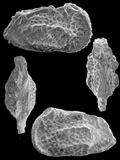 Abstract: This paper describes thirteen new species and
two new genera of marine and brackish water ostracodes from the Turonian
deposits of Potiguar Basin, NE Brazil, among a total of 53 taxa. The new
species include Cophinia grekoffi, Fossocytheridea tiberti, Haughtonileberis dinglei, Hemicytherura viviersae,
Jandairella obesa (new genus and species), Loxocorniculum? narendrai, Ovocytheridea posteroprojecta, O. reymenti, Perissocytheridea caudata,
P. mossoroensis, Potiguarella grosdidieri (new genus and species), P. coimbrai and Procytherura ballentae.
The diversity and dominance indexes vary according to the paleoenvironment.
Three assemblages were identified: a predominantly mixohaline fauna in the
basal part of the section, followed by a diversified shallow marine fauna and,
in the upper part, a marine and brackish water ostracode fauna. Most of the
recorded species are endemic. Eight species are common to Northwest and North
Africa, indicating a faunal link during the Turonian. The study of the Turonian
faunas of the Potiguar Basin represents a significant improvement to understand
the dynamic evolution of the Brazilian basins and the paleobiogeographical
relationship with other regions. Abstract: This paper describes thirteen new species and
two new genera of marine and brackish water ostracodes from the Turonian
deposits of Potiguar Basin, NE Brazil, among a total of 53 taxa. The new
species include Cophinia grekoffi, Fossocytheridea tiberti, Haughtonileberis dinglei, Hemicytherura viviersae,
Jandairella obesa (new genus and species), Loxocorniculum? narendrai, Ovocytheridea posteroprojecta, O. reymenti, Perissocytheridea caudata,
P. mossoroensis, Potiguarella grosdidieri (new genus and species), P. coimbrai and Procytherura ballentae.
The diversity and dominance indexes vary according to the paleoenvironment.
Three assemblages were identified: a predominantly mixohaline fauna in the
basal part of the section, followed by a diversified shallow marine fauna and,
in the upper part, a marine and brackish water ostracode fauna. Most of the
recorded species are endemic. Eight species are common to Northwest and North
Africa, indicating a faunal link during the Turonian. The study of the Turonian
faunas of the Potiguar Basin represents a significant improvement to understand
the dynamic evolution of the Brazilian basins and the paleobiogeographical
relationship with other regions.
|
|
Carnets Geol., vol. 14, no. 12, p. 211-252
Published online in final form (pdf) on July 3, 2014
|
|
Erratum: The
table rows of Appendix 2 (i.e.,
"Distribution of the ostracode species, with their abundances") should
have included numbers.
|
|
Format [PDF
78 KB]
Online since July 27, 2014
|
|
First record of lowermost Cretaceous shallow-water limestones in the basement of the Transylvanian Depression (Romania)
Ioan I. BUCUR, Adriana PĂCURARIU, Emanoil SĂSĂRAN, Sorin FILIPESCU & Rodica FILIPESCU
| HTML  | PDF
| PDF  [1,655 KB]
| DOI:
10.4267/2042/54001 [1,655 KB]
| DOI:
10.4267/2042/54001
|
|
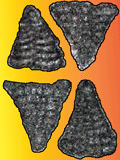 Abstract: Triassic,
Upper Jurassic and upper Lower Cretaceous sedimentary formations were previously
studied from the Transylvanian Depression basement, but the presence of
lowermost Cretaceous (Berriasian-Valanginian) has not been confirmed paleontologically. The carbonate sequence cored from a borehole drilled in the
central part of the Transylvanian Depression yields microfossil assemblages dominated by benthic
foraminifera. These new data unequivocally document the presence of characteristic Berriasian-Valanginian
taxa in these deposits. Abstract: Triassic,
Upper Jurassic and upper Lower Cretaceous sedimentary formations were previously
studied from the Transylvanian Depression basement, but the presence of
lowermost Cretaceous (Berriasian-Valanginian) has not been confirmed paleontologically. The carbonate sequence cored from a borehole drilled in the
central part of the Transylvanian Depression yields microfossil assemblages dominated by benthic
foraminifera. These new data unequivocally document the presence of characteristic Berriasian-Valanginian
taxa in these deposits.
|
|
Carnets Geol., vol. 14, no. 11, p. 199-210
Published online in final form (pdf) on July 3, 2014
|
|
A new type of entombment of Peronopsis (Agnostida) in a hyolithid conch
Oldřich FATKA & Vladislav KOZÁK
| HTML  | PDF
| PDF  [592 KB]
| DOI:
10.4267/2042/54000 [592 KB]
| DOI:
10.4267/2042/54000
|
|
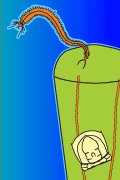 Abstract: An enrolled exoskeleton of the holaspid specimen of a tiny agnostid Peronopsis integra (Beyrich,
1845) entombed inside a conch of the hyolithid ?Buchavalites sp. is described from the middle Cambrian (Drumian) Jince Formation of the Příbram-Jince Basin (Czech Republic). The agnostid is associated with an ichnofossil of the feeding trace classified as Arachnostega-type behaviour. The enrolled attitude of the agnostid exoskeleton suggests that the specimen is a carcass rather than moult. Either the storm disturbance and/or well-protected source of food
hypotheses could explain the entombed agnostid. This additional example supports a benthic mode of life in the agnostid P. integra. The studied association of feeding tunnels of an unknown Arachnostega-strategist and Peronopsis preserved inside a hyolithid conch is a case of "frozen" behaviour. Abstract: An enrolled exoskeleton of the holaspid specimen of a tiny agnostid Peronopsis integra (Beyrich,
1845) entombed inside a conch of the hyolithid ?Buchavalites sp. is described from the middle Cambrian (Drumian) Jince Formation of the Příbram-Jince Basin (Czech Republic). The agnostid is associated with an ichnofossil of the feeding trace classified as Arachnostega-type behaviour. The enrolled attitude of the agnostid exoskeleton suggests that the specimen is a carcass rather than moult. Either the storm disturbance and/or well-protected source of food
hypotheses could explain the entombed agnostid. This additional example supports a benthic mode of life in the agnostid P. integra. The studied association of feeding tunnels of an unknown Arachnostega-strategist and Peronopsis preserved inside a hyolithid conch is a case of "frozen" behaviour.
|
|
Carnets Geol., vol. 14, no. 10, p. 191-198
Published online in final form (pdf) on July 3, 2014
|
|
The Cretaceous-Paleogene boundary and its 405-kyr eccentricity cycle phase: a new constraint on radiometric dating and astrochronology
Michel HENNEBERT
| HTML  | PDF
| PDF  [547 KB]
| DOI:
10.4267/2042/53981 [547 KB]
| DOI:
10.4267/2042/53981
|
|
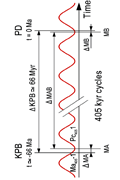 Abstract: Radiometric dating and astrochronologic dating still suffer discrepancies without knowing which one gives the most reliable results. A new tool is proposed to constrain both the approaches. The phase of the 405-kyr signal with respect to the Cretaceous - Paleogene boundary event has been determined in the Aïn Settara section (Kalaat Senan, central Tunisia). We use this phase value (Option 2), as well as an average of phase values obtained from the literature (Option 1), to examine the relationship linking both the radiometric (absolute) age assigned to the K-Pg boundary and the Cenozoic average-value of the ~405-kyr eccentricity period. A new useful constraint emerges: to any absolute age assumed for the K-Pg boundary corresponds a value of the mean Cenozoic 405-kyr period, and vice versa. Abstract: Radiometric dating and astrochronologic dating still suffer discrepancies without knowing which one gives the most reliable results. A new tool is proposed to constrain both the approaches. The phase of the 405-kyr signal with respect to the Cretaceous - Paleogene boundary event has been determined in the Aïn Settara section (Kalaat Senan, central Tunisia). We use this phase value (Option 2), as well as an average of phase values obtained from the literature (Option 1), to examine the relationship linking both the radiometric (absolute) age assigned to the K-Pg boundary and the Cenozoic average-value of the ~405-kyr eccentricity period. A new useful constraint emerges: to any absolute age assumed for the K-Pg boundary corresponds a value of the mean Cenozoic 405-kyr period, and vice versa.
Supposing a K-Pg boundary radiometric age in the vicinity of 66.0 Ma, then the number of entire cycles (comprised between two minima of the 405-kyr eccentricity signal) within the Cenozoic Period could only be equal to 163. When adding to this figure the parts of the cycles preceding and following these 163 entire cycles the total duration of the Cenozoic Era becomes equal to 163.168 cycles (Option 1) or 163.081 cycles (Option 2).
We propose to grant a special interest to the determination of the 405-kyr cycle phase at stratigraphically well documented levels, particularly those that correspond to world-wide, sudden and catastrophic events, that are well located in time by reliable radiometric dates.
|
|
Carnets Geol., vol. 14, no. 9, p. 173-189
Published online in final form (pdf) on June 19, 2014
|
|
Novocrania turbinata synonym of N. anomala
Christian C. EMIG
| HTML  | PDF
| PDF  [2,664 KB]
| DOI:
10.4267/2042/53979 [2,664 KB]
| DOI:
10.4267/2042/53979
|
|
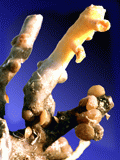 Abstract: Anomia turbinata, or conical Anomia (= Novocrania turbinata), was described by Poli
(1795) in the
bathyal environment off the coast of the Kingdom of the Two Sicilies, Patella anomala Müller, 1776 (= N. anomala)
being considered a synonym. The history of this species, commonly considered as the Mediterranean form of N. anomala,
will be described. Recently, several authors have described N. turbinata as a valid species on the basis of shell variations,
as compared to N. anomala. After analysis of the taxonomic
validity of these characters, both species are considered as
synonymous. That is supported by their occurrence in various localities, mainly
in the continental shelf. Their synonymy has been corroborated by molecular
analyses and is discussed with reference to the characteristics of the Mediterranean basins and their history since the
Miocene. Abstract: Anomia turbinata, or conical Anomia (= Novocrania turbinata), was described by Poli
(1795) in the
bathyal environment off the coast of the Kingdom of the Two Sicilies, Patella anomala Müller, 1776 (= N. anomala)
being considered a synonym. The history of this species, commonly considered as the Mediterranean form of N. anomala,
will be described. Recently, several authors have described N. turbinata as a valid species on the basis of shell variations,
as compared to N. anomala. After analysis of the taxonomic
validity of these characters, both species are considered as
synonymous. That is supported by their occurrence in various localities, mainly
in the continental shelf. Their synonymy has been corroborated by molecular
analyses and is discussed with reference to the characteristics of the Mediterranean basins and their history since the
Miocene.
|
|
Carnets Geol., vol. 14, no. 8, p. 159-171
Published online in final form (pdf) on June 19, 2014
|
|
Heydrichia (?) poignantii, sp. nov. (Sporolithaceae, Sporolithales, Rhodophyta), a 100 million year old fossil coralline red alga from north-eastern Brazil, and a new Hauterivian record of Sporolithon from Switzerland
William J. WOELKERLING, Bruno GRANIER & Dimas DIAS-BRITO
| HTML  | PDF
| PDF  [4,062 KB]
| DOI:
10.4267/2042/53736 [4,062 KB]
| DOI:
10.4267/2042/53736
|
|
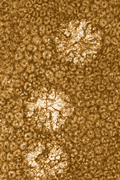 Abstract: Fossil
specimens of Heydrichia (?) poignantii, sp. nov. (Sporolithaceae,
Sporolithales, Rhodophyta), representing the first confirmation of the genus in
the fossil record, were discovered in thin sections of Albian limestones from
the Riachuelo Formation, Sergipe Basin, and in thin sections of Albian -
Cenomanian limestones from the Ponta do Mel Formation, Potiguar Basin in
north-eastern Brazil. A detailed morphological-anatomical account of the species
is provided, and its placement in Heydrichia is discussed in relation to
current classification proposals. Comparisons with the four other known species
of the genus, all non-fossil, show that H. poignantii is the only known
species of Heydrichia in which thalli are encrusting to sparsely warty to
horizontally layered with overlapping lamellate branches that commonly appear
variously curved or arched, and in which thalli have sporangial complexes that
become buried in the thallus. The evolutionary history of Heydrichia
remains uncertain, but available data suggest that the genus may have diverged
from the sporolithacean genus Sporolithon, known as early as Hauterivian
times (c. 129.4-132.9 ± 1 Ma) from Spain (and newly reported here from
Switzerland), or it may have arisen from a graticulacean alga such as Graticula,
dating from mid-Silurian times (c. 427-435 Ma). Current data also suggest
that Heydrichia is more likely to have arrived in Brazil from Central
Atlantic waters than from higher latitude South Atlantic waters. This implies
that currently living species in southern Africa probably arose later from
ancestors further equatorward in the South Atlantic, although confirming studies
are needed. All non-fossil species of Heydrichia are known only from the
southern hemisphere. Abstract: Fossil
specimens of Heydrichia (?) poignantii, sp. nov. (Sporolithaceae,
Sporolithales, Rhodophyta), representing the first confirmation of the genus in
the fossil record, were discovered in thin sections of Albian limestones from
the Riachuelo Formation, Sergipe Basin, and in thin sections of Albian -
Cenomanian limestones from the Ponta do Mel Formation, Potiguar Basin in
north-eastern Brazil. A detailed morphological-anatomical account of the species
is provided, and its placement in Heydrichia is discussed in relation to
current classification proposals. Comparisons with the four other known species
of the genus, all non-fossil, show that H. poignantii is the only known
species of Heydrichia in which thalli are encrusting to sparsely warty to
horizontally layered with overlapping lamellate branches that commonly appear
variously curved or arched, and in which thalli have sporangial complexes that
become buried in the thallus. The evolutionary history of Heydrichia
remains uncertain, but available data suggest that the genus may have diverged
from the sporolithacean genus Sporolithon, known as early as Hauterivian
times (c. 129.4-132.9 ± 1 Ma) from Spain (and newly reported here from
Switzerland), or it may have arisen from a graticulacean alga such as Graticula,
dating from mid-Silurian times (c. 427-435 Ma). Current data also suggest
that Heydrichia is more likely to have arrived in Brazil from Central
Atlantic waters than from higher latitude South Atlantic waters. This implies
that currently living species in southern Africa probably arose later from
ancestors further equatorward in the South Atlantic, although confirming studies
are needed. All non-fossil species of Heydrichia are known only from the
southern hemisphere.
|
|
Carnets Geol., vol. 14, no. 7, p. 139-158
Published online in final form (pdf) on May 8, 2014
|
|
A negative carbon isotope excursion within the Dufrenoyia furcata Zone: proposal for a new episode for chemo-stratigraphic correlation in the Aptian
Fernando NUÑEZ-USECHE, Josep Anton MORENO-BEDMAR, Miguel COMPANY & Ricardo BARRAGÁN
| HTML  | PDF
| PDF  [500 KB]
| DOI:
10.4267/2042/53734 [500 KB]
| DOI:
10.4267/2042/53734
|
|
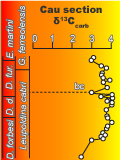 Abstract: In this work we discuss a proposed updated division of the C7 isotope segment of Menegatti et al. (1998). The new standard division of the segment C7 is based on a revision of published Barremian-Aptian carbon isotope curves from stratigraphic sections of the Prebetic
Domain in Spain. It includes four distinct isotopic subunits labeled C7a to C7d, with a characteristic negative carbon isotope excursion at the base of the segment and which correlates with the Dufrenoyia furcata ammonite Zone. The negative excursion is recognized on a regional
extent, and the term Intra-Furcata Negative Excursion (IFNE) is proposed to identify it. We provide possible sites correlatable with the IFNE in both the Old and New
worlds, which suggest its potential use as an even global chemostratigraphic marker for the Aptian record. Abstract: In this work we discuss a proposed updated division of the C7 isotope segment of Menegatti et al. (1998). The new standard division of the segment C7 is based on a revision of published Barremian-Aptian carbon isotope curves from stratigraphic sections of the Prebetic
Domain in Spain. It includes four distinct isotopic subunits labeled C7a to C7d, with a characteristic negative carbon isotope excursion at the base of the segment and which correlates with the Dufrenoyia furcata ammonite Zone. The negative excursion is recognized on a regional
extent, and the term Intra-Furcata Negative Excursion (IFNE) is proposed to identify it. We provide possible sites correlatable with the IFNE in both the Old and New
worlds, which suggest its potential use as an even global chemostratigraphic marker for the Aptian record.
|
|
Carnets Geol., vol. 14, no. 6, p. 129-137
Online since May 8, 2014
|
|
The Albian Stage in its type area, the Aube (France): a synthesis in a global sedimentary context
Francis AMÉDRO & Bertrand MATRION
| HTML  | PDF
| PDF  [2,810 KB]
| DOI:
10.4267/2042/53732 [2,810 KB]
| DOI:
10.4267/2042/53732
|
|
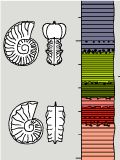 Abstract: The Aube department is the type locality of the Albian stage created by d'Orbigny
(1842). Two formations are recognised in the clay facies
(the "Gault" auct.) of the stratotype, the Argiles tégulines de Courcelles (82 m), which is overlain by the Marnes de Brienne (43 m). The boundary between the two formations is defined at the top of an indurated bed (hardground
L'Étape) that is readily identifiable, both in the field, and from boreholes. The type area of the Albian stage is of great interest because of the size of the clay facies (more than 120 m) unique in the Anglo-Paris basin.
Today, 82 % of the lithological succession is documented accurately from 16
outcrops. In two intervals of respectively 33 m and 28.50 m thick, composite sections are made of overlapping sections which are correlated in the field with the help of lithological marker
beds. Six successive facies are described: in the Argiles tégulines de Courcelles and from bottom to top: 1 - phosphatic nodules
bed; 2 - silty clays; 3 - clays and limestone beds; in the Marnes de Brienne: 4 - clay
marls; 5 - gaize; 6 - clay marls. On a smaller scale, a decimetre to metre-scale rhythmicity can be identified in the
sedimentation. This is reflected in the Argiles tégulines de Courcelles by pluri-decimetric cycles that start with a silty level and are bounded at the top by a bored surface. In the Marnes de Brienne, the metric cycles
(except for the gaize where they are decimetric) exhibit alternating dark grey clay marl and a pale grey marl that herald the rhythmic chalks of the Cenomanian. Individual couplets probably represent the precession cycles (20
kyr). On the other hand, 13 lithoevents as phosphatic nodules beds, hardgrounds, glauconitic and sandy beds and ecoevents characterised by the brief abundance of
some fossils. These marker beds are very useful for fine correlations across the basin. A comparison is proposed between sandy units of Yonne and clay facies of Aube. The continuity of several phosphatic nodules beds is shown from Yonne in the South West to Aube and Perthois in the North
East, that is a distance exceeding 130 km. These marker beds are interpreted as Flooding Surfaces of 3rd-order cycles.
Finally, a detailed study of the lithology, complemented with the analysis of the ammonite and inoceramid
faunas, is used for a depositional sequence interpretation. As a result, eight sequences are identified in the upper half of the Argiles tégulines de Courcelles and in the Marnes de Brienne in the type area of the Albian stage, including two new sequences indexed AL 5a and AL
6a. Abstract: The Aube department is the type locality of the Albian stage created by d'Orbigny
(1842). Two formations are recognised in the clay facies
(the "Gault" auct.) of the stratotype, the Argiles tégulines de Courcelles (82 m), which is overlain by the Marnes de Brienne (43 m). The boundary between the two formations is defined at the top of an indurated bed (hardground
L'Étape) that is readily identifiable, both in the field, and from boreholes. The type area of the Albian stage is of great interest because of the size of the clay facies (more than 120 m) unique in the Anglo-Paris basin.
Today, 82 % of the lithological succession is documented accurately from 16
outcrops. In two intervals of respectively 33 m and 28.50 m thick, composite sections are made of overlapping sections which are correlated in the field with the help of lithological marker
beds. Six successive facies are described: in the Argiles tégulines de Courcelles and from bottom to top: 1 - phosphatic nodules
bed; 2 - silty clays; 3 - clays and limestone beds; in the Marnes de Brienne: 4 - clay
marls; 5 - gaize; 6 - clay marls. On a smaller scale, a decimetre to metre-scale rhythmicity can be identified in the
sedimentation. This is reflected in the Argiles tégulines de Courcelles by pluri-decimetric cycles that start with a silty level and are bounded at the top by a bored surface. In the Marnes de Brienne, the metric cycles
(except for the gaize where they are decimetric) exhibit alternating dark grey clay marl and a pale grey marl that herald the rhythmic chalks of the Cenomanian. Individual couplets probably represent the precession cycles (20
kyr). On the other hand, 13 lithoevents as phosphatic nodules beds, hardgrounds, glauconitic and sandy beds and ecoevents characterised by the brief abundance of
some fossils. These marker beds are very useful for fine correlations across the basin. A comparison is proposed between sandy units of Yonne and clay facies of Aube. The continuity of several phosphatic nodules beds is shown from Yonne in the South West to Aube and Perthois in the North
East, that is a distance exceeding 130 km. These marker beds are interpreted as Flooding Surfaces of 3rd-order cycles.
Finally, a detailed study of the lithology, complemented with the analysis of the ammonite and inoceramid
faunas, is used for a depositional sequence interpretation. As a result, eight sequences are identified in the upper half of the Argiles tégulines de Courcelles and in the Marnes de Brienne in the type area of the Albian stage, including two new sequences indexed AL 5a and AL
6a.
|
|
Carnets Geol., vol. 14, no. 5, p. 69-128
Online since May 8, 2014
|
|
Paleocene larger foraminifera from the Yucatán Peninsula (SE Mexico)
Vicent VICEDO, José Antonio BERLANGA & Josep SERRA-KIEL
| HTML  | PDF
| PDF  [11,544 KB]
| DOI:
10.4267/2042/53527 [11,544 KB]
| DOI:
10.4267/2042/53527
|
|
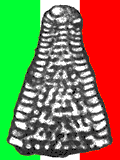 Abstract: The
larger foraminifera found in the material from the Chichen Itzá Formation of
Campeche (SE Mexico) were studied in detail. The architectural analyses allow
the description of four new species and a new genus, namely, two agglutinated
conical foraminifera, Coskinolina yucatanensis n.sp. and Pseudofallotella
drobneae n. gen. n.sp., one new alveolinid, Borelis hottingeri n.sp.,
and one new rotaliid, Dictyoconoides boneti n.sp. The larger foraminifera
of the Chichen Itzá Formation are distributed across two different
associations: one includes Pseudofallotella drobneae, Neotaberina
sp., Rhabdorites sp., Borelis hottingeri, Dictyoconoides boneti,
Kathina sp., Miscellaneidae, Ranikothalia soldadensis and Hexagonocyclina
cristensis, while the other assemblage is composed of Coskinolina
yucatensis, Fallotella causae, Rhabdorites sp., Borelis
floridanus and Cincoriola cf. ovoidea. Some of these genera,
including Neotaberina and Dictyoconoides, are cited in the
Caribbean paleobioprovince for the first time in this paper. The first
association is dated as Thanetian (SBZ 3? to SBZ 4) by the presence of
Ranikothalia soldadensis. Though the age of the second association
remains uncertain, a similar age has been inferred. Abstract: The
larger foraminifera found in the material from the Chichen Itzá Formation of
Campeche (SE Mexico) were studied in detail. The architectural analyses allow
the description of four new species and a new genus, namely, two agglutinated
conical foraminifera, Coskinolina yucatanensis n.sp. and Pseudofallotella
drobneae n. gen. n.sp., one new alveolinid, Borelis hottingeri n.sp.,
and one new rotaliid, Dictyoconoides boneti n.sp. The larger foraminifera
of the Chichen Itzá Formation are distributed across two different
associations: one includes Pseudofallotella drobneae, Neotaberina
sp., Rhabdorites sp., Borelis hottingeri, Dictyoconoides boneti,
Kathina sp., Miscellaneidae, Ranikothalia soldadensis and Hexagonocyclina
cristensis, while the other assemblage is composed of Coskinolina
yucatensis, Fallotella causae, Rhabdorites sp., Borelis
floridanus and Cincoriola cf. ovoidea. Some of these genera,
including Neotaberina and Dictyoconoides, are cited in the
Caribbean paleobioprovince for the first time in this paper. The first
association is dated as Thanetian (SBZ 3? to SBZ 4) by the presence of
Ranikothalia soldadensis. Though the age of the second association
remains uncertain, a similar age has been inferred.
|
|
Carnets Geol., vol. 14, no. 4, p. 41-68
Online since March 17, 2014
|
|
Acanthocythereis colini nomen novum for A. reticulata Sciuto, 2014
Francesco SCIUTO
| HTML  | PDF
| PDF  [27 KB]
| DOI:
10.4267/2042/53523 [27 KB]
| DOI:
10.4267/2042/53523
|
|
Excerpt: In Sciuto (2014), a new species, Acanthocythereis reticulata, was described from the Upper Pliocene sediments of NE Sicily and belonging to the
Family Trachyleberididae Sylvester-Bradley, 1948. (...)
|
|
Carnets Geol., vol. 14, no. 3, p. 39
Online since February 28, 2014
|
|
A Cretaceous chronostratigraphic database: construction and applications
Robert W. SCOTT
| HTML  | PDF
| PDF  [1,718 KB]
| DOI:
10.4267/2042/53522 [1,718 KB]
| DOI:
10.4267/2042/53522
|
|
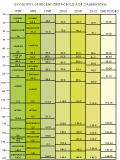 Abstract: Timing and rates of tectonic events, evolutionary processes, and oceanographic and paleoclimatic changes must be based on high-precision numerical age calibration of stages defined in Global Stratotype and Section Points (GSSPs). The Cretaceous Chronostratigraphic Database (CRETCSDB3) is an objective, testable database that calibrates select Cretaceous events and enables high-resolution chronostratigraphic correlations. Abstract: Timing and rates of tectonic events, evolutionary processes, and oceanographic and paleoclimatic changes must be based on high-precision numerical age calibration of stages defined in Global Stratotype and Section Points (GSSPs). The Cretaceous Chronostratigraphic Database (CRETCSDB3) is an objective, testable database that calibrates select Cretaceous events and enables high-resolution chronostratigraphic correlations.
CRETCSDB3 is a compilation of more than 3500 taxa and marker beds in
nearly 300 published sections calibrated to a mega-annum
(Ma) scale. The database spans the Jurassic/Cretaceous and the Cretaceous/Paleogene boundaries. Construction of CRETCSDB3 began by plotting bioevents in the Kalaat Senan, Tunisia, Cenomanian-Turonian section to the 1989 time scale. The sedimentology, sequence stratigraphy, and biostratigraphy of this section were precisely documented and stage boundaries defined biostratigraphically. Additional sections with radiometrically dated beds were graphed to constrain the accuracy of the numerical scale. Ranges of first and last occurrences are calibrated to mega-annums of Cretaceous stages defined by GSSPs or reference sections. This database serves as a look-up table for interpolation and age calibration of other stratigraphic sections. The age ranges of some taxa and marker beds are preliminary and may be extended as new sections are added to the database.
CRETCSDB3 tested the numeric age calibration of the Albian/Cenomanian boundary. This boundary in North Texas accurately correlates with the GSSP in France by ammonites, planktic foraminifers and dinoflagellates. This stage boundary in North Texas correlates with the 97.88±0.69 Ma Clay Spur Bentonite in Wyoming by sequence stratigraphy and cosmopolitan dinoflagellates. The inconsistency between this age and the current 100.5 Ma date of the 2012 Geologic Time Scale remains to be evaluated independently.
|
|
Carnets Geol., vol. 14, no. 2, p. 15-37
Online since February 28, 2014
|
|
Ostracods of the Upper Pliocene - Pleistocene Punta Mazza succession (NE Sicily) with special focus on the Family Trachyleberididae Sylvester-Bradley, 1948, and description of a new species
Francesco SCIUTO
| HTML  | PDF
| PDF  [1,980 KB]
| DOI:
10.4267/2042/53172 [1,980 KB]
| DOI:
10.4267/2042/53172
|
|
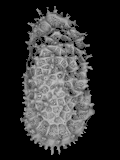 Abstract: The ostracod associations of the Upper Pliocene-Pleistocene sedimentary succession out-cropping at Punta Mazza (Milazzo, Sicily NE) have been investigated. The ostracod fauna is often well-preserved and well-diversified:
there 42 species belonging to 24 genera have been found. The association consists almost exclusively of bathyal taxa such as Bythocypris obtusata (Sars), B. bosquetiana (Brady), Henryhowella ex H. profunda Bonaduce et al. group, Quasibuntonia radiatopora (Seguenza), Retibythere (Bathybythere) scaberrima Brady, Pseudocythere caudata Sars and Bythocythere mylaensis Sciuto. Also, the Krithe group is well-represented with Krithe compressa (Seguenza) and K. pernoides (Bornemann). Further taxa such as Cytheropteron testudo Sars are rare. Almost all species, especially those belonging to Trachyleberididae Sylvester-Bradley
are described, illustrated and commented on, including a new species, Acanthocythereis reticulata n.sp., found in the lower part of the section
in Upper Pliocene sediment, is proposed as new. Finally, a
specimen belonging to the genus Quasibuntonia Ruggieri is currently given in open nomenclature. Abstract: The ostracod associations of the Upper Pliocene-Pleistocene sedimentary succession out-cropping at Punta Mazza (Milazzo, Sicily NE) have been investigated. The ostracod fauna is often well-preserved and well-diversified:
there 42 species belonging to 24 genera have been found. The association consists almost exclusively of bathyal taxa such as Bythocypris obtusata (Sars), B. bosquetiana (Brady), Henryhowella ex H. profunda Bonaduce et al. group, Quasibuntonia radiatopora (Seguenza), Retibythere (Bathybythere) scaberrima Brady, Pseudocythere caudata Sars and Bythocythere mylaensis Sciuto. Also, the Krithe group is well-represented with Krithe compressa (Seguenza) and K. pernoides (Bornemann). Further taxa such as Cytheropteron testudo Sars are rare. Almost all species, especially those belonging to Trachyleberididae Sylvester-Bradley
are described, illustrated and commented on, including a new species, Acanthocythereis reticulata n.sp., found in the lower part of the section
in Upper Pliocene sediment, is proposed as new. Finally, a
specimen belonging to the genus Quasibuntonia Ruggieri is currently given in open nomenclature.
|
|
Carnets Geol., vol. 14, no. 1, p. 1-13
Online since January 25, 2014
|
|
|
|